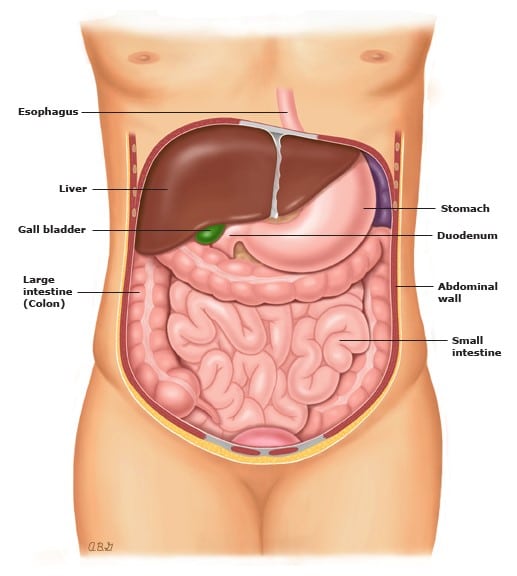Gallstones are small stones that form inside the gallbladder. They can be tiny specks or get as big as the whole gallbladder, which can be up to 6 inches long.
Normally, the gallbladder fills with bile in between meals. Then, when you eat fatty foods, the gallbladder empties the bile into the intestine. Sometimes, though, gallstones clog the gallbladder and keep it from draining. Other times, gallstones just irritate the gallbladder. If the gallstones are pushed out of the gallbladder, they can keep the liver or pancreas from draining.
In most cases, gallstones do not cause any symptoms. When they do cause symptoms, gallstones can cause:
- Belly pain – Often on the right side just under the rib cage or in the middle top portion of the belly
- Pain in the back or right shoulder
- Nausea and vomiting
If you know that you have gallstones but have no symptoms, you probably will not need treatment. But if you start having symptoms, you should get treated. The symptoms can come and go, but they often get worse over time.
Not usually. In some cases they can lead to serious problems, including:
- Jaundice, a condition that turns your skin and eyes yellow
- Infection of the gallbladder
- Tears in the gallbladder, which can lead to death
- Inflammation of the pancreas (the pancreas is an organ that makes hormones and juices involved in food breakdown)
Yes, doctors can find out if you have gallstones by doing an imaging test, such as an ultrasound. An ultrasound is a painless test that uses sound waves to create a picture of your gallbladder.
Even if tests show that you have gallstones, that does not mean they are causing symptoms. Your doctor might need to do other tests to make sure your stones and your symptoms are related.
People with gallstones generally have 3 treatment options. They can have:
- No treatment– This option is best for most people who have no symptoms. If they start having symptoms, they can think about treatment then.
- Surgery to remove the gallbladder and the stones– Gallbladder surgery is routine in the United States. But it involves using anesthesia, so it has some risks. The surgery does not affect digestion very much. But about half the people who have surgery have mild symptoms afterward, including watery bowel movements, gas, or bloating. These symptoms usually get better. People who have their gallbladder removed do not need to worry about gallstones coming back.
- Treatment to get rid of the stones but keep the gallbladder– People who choose this approach can take medicines to break up gallstones. In rare cases, doctors can use with a device to break up and remove stones. Medicines only work with some stones, and even then they take time – months to years. The stones can also come back after these treatments.
The right treatment for you will depend on:
- How large your stones are
- Whether you have symptoms, and how bad the symptoms are
- How you feel about the treatment options
Ask your doctor or nurse how each treatment might affect you. Then work with them to find the treatment that makes the most sense for you.
Yes. You can try to keep yourself at a healthy weight. People who are overweight are more likely to get gallstones.
If you plan to lose weight quickly – even if you have never had gallstones – ask your doctor or nurse what you can do to keep from getting gallstones. Losing weight quickly – for example, through weight loss surgery – can lead to gallstones. But your doctor or nurse can give you medicines to keep that from happening.
The gallbladder is a small, pear-shaped organ that is tucked under the liver. It stores bile, a fluid that is made in the liver and helps the body break down fat. When you eat a meal that has fat in it, the gallbladder empties the bile into a tube called the “bile duct.” The bile duct carries the bile into the small intestine to help with digestion.
Gallbladder removal is surgery to remove the gallbladder. This surgery is also called “cholecystectomy.”
There are 2 main ways to remove the gallbladder:
- Laparoscopic surgery– This means the surgeon uses a “laparoscope,” a long, thin tube that has a light and a tiny camera on the end to see inside the body. (The laparoscope is sometimes called a “scope” for short.) For this type of surgery, the surgeon makes a few small incisions. Then they insert the scope through 1 of the incisions and other special tools through the other incisions. Next the surgeon uses the scope and the tools to do the operation. Most gallbladder removals in the US are done using laparoscopic surgery. Sometimes, though, open surgery is necessary because the gallbladder and bile duct are too infected or scarred to do laparoscopic surgery safely.
- Open surgery– This means the surgeon makes an incision in your belly big enough to do the surgery directly.
The most common reason is to treat gallstones. Gallstones are small stones that form inside the gallbladder. These stones can block the ducts that bile flows through. The stones can cause inflammation, pain, and other symptoms.
This article is about gallbladder removal to treat gallstones. People can also have gallbladder removal to treat cancer of the gallbladder. But if cancer is the reason for the surgery, it usually involves removing more than just the gallbladder.
Before the surgery:
- Your doctor will order blood tests to check if your liver is working normally.
- Your doctor will order an imaging test called an ultrasound, which uses sound waves to create pictures of the inside of your body. This test will show if you have gallstones and if the bile duct is enlarged or blocked.
- If the bile duct is blocked by a stone, your doctor might order a procedure called “ERCP.” ERCP stands for “endoscopic retrograde cholangiopancreatography.” During this procedure, a doctor slides a tube called an “endoscope” down your throat. The endoscope has a tiny camera and a light on the end. The doctor advances the tube past your stomach and into your intestine to the spot where the bile duct empties into the intestine. Then the doctor injects a special dye that shows up on X-ray into the ducts that leads to the gallbladder, liver, and pancreas and takes an X-ray. That way they can see where the dye goes. In some cases, the doctor might also use the endoscope to remove some gallstones or widen the duct opening so that small stones can pass through.
- Your doctor might give you antibiotics through a thin tube that goes into a vein, called an “IV,” to reduce the risk of infection during and after surgery.
If you have the surgery to treat gallstones, the main benefit is that it will make your symptoms go away.
The risks of the surgery are low, but they can include:
- Damage to other bile ducts near the gallbladder
- Bile leaks
- Bleeding
- Damage to the bowels
- Infection
- Leaving gallstones “trapped” in the bile duct (which would need to be removed with ERCP after surgery)
In some cases, a person will continue to have belly pain even after the gallbladder is removed.
Recovery is a little different depending on whether you have laparoscopic or open surgery.
- If you have laparoscopic surgery, you will probably be able to leave the hospital the same day you have surgery. But there is some chance you will need to stay overnight. Even though the cuts on the belly are small, the operation inside was the same as if you had open surgery. Your doctor will want you to rest and avoid heavy lifting, sports, and swimming for at least a week.
- If you have open surgery, you will probably stay in the hospital for 1 to 2 days. While there, do your best to start walking as soon as possible. Also, do the breathing exercises that your nurse recommends. After you go home, you should be able to do most of your normal activities, but you should avoid heavy lifting, sports, and swimming for a few weeks.
If you are taking narcotic pain medicine during recovery, you might get constipated. Take a stool softener to prevent this problem.
If you develop any the following symptoms in the weeks after surgery, call your doctor:
- Fever or chills
- Redness or swelling around the cuts from your surgery
- Nausea or vomiting
- Cramping or more severe belly pain
- Bloating (feeling like your belly is full of gas)
- Yellow skin or eyes
- Urine that is very dark in color
The surgery does not affect digestion very much. But about half the people who have surgery have mild symptoms afterward, including loose bowel movements, gas, or bloating. These symptoms usually get better.




